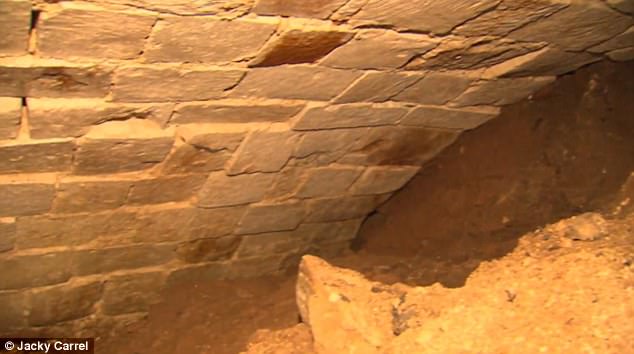A secret spy chamber that was built by the mother of Ivan the Terrible has been found under a Moscow street.
Archaeologists said the room was originally constructed beneath a 1.5 mile wall designed to protect Russians from Tatar and Polish raids during the 16th Century.
The vaulted wall is believed to have created an acoustic effect that allowed Russians to easily hear the enemy on the other side.
Archaeologists unearth 16th Century secret spy chamber which Ivan the Terrible's mother built under a street in Moscow
The chamber was built under a 1.5-mile wall used to keep out invaders
The wall's vaulted design meant Russians in the room could hear the enemy
Around 150 artefacts dating from between the 16th to 19th Century were found
By Joe Sheppard For Mailonline
2 April 2017
A secret spy chamber that was built by the mother of Ivan the Terrible has been found under a Moscow street.
Archaeologists said the room was originally constructed beneath a 1.5 mile wall designed to protect Russians from Tatar and Polish raids during the 16th Century.
The vaulted wall is believed to have created an acoustic effect that allowed Russians to easily hear the enemy on the other side.

Russian archaeologists have unearthed a spy chamber in Moscow

The chamber was discovered by builders doing construction work in the centre of the city

The room was built by Elena Glinskaya, the mother of Ivan the Terrible, pictured
The room was discovered by builders doing construction work in the centre of the city.
Inside archaeologists found some 150 artefacts dating from the 16th to 19th Century.
It is believed the chamber was last used as a spy room in the 17th Century during conflict with the Poles. During times of peace it was used to store food.
Leonid Kondrashev, Moscow's chief archaeologist, told RT the room was built 'by Elena Glinskaya, the mother of Ivan the Terrible, who led Russia in the 1530s'.

Experts will decide whether the chamber should be opened to the public or preserved as it is

The vaulted wall is believed to have created an acoustic effect that allowed Russians to easily hear the enemy on the other side

Inside archaeologists found some 150 artifacts dating from the 16th to 19th Century
Another archaeologist who worked on the site told Interfax news agency: 'The majority of the artefacts are 18-19th century ceramics: fragments of pots, bowls. There is even a very well preserved ceramic cup.
'A dozen copper coins, lead trade sealing marks, iron knives, nails were also found.'
Experts will decide whether the chamber should be opened to the public or preserved as it is.
Archaeologists said the room was originally constructed beneath a 1.5 mile wall designed to protect Russians from Tatar and Polish raids during the 16th Century.
The vaulted wall is believed to have created an acoustic effect that allowed Russians to easily hear the enemy on the other side.
Archaeologists unearth 16th Century secret spy chamber which Ivan the Terrible's mother built under a street in Moscow
The chamber was built under a 1.5-mile wall used to keep out invaders
The wall's vaulted design meant Russians in the room could hear the enemy
Around 150 artefacts dating from between the 16th to 19th Century were found
By Joe Sheppard For Mailonline
2 April 2017
A secret spy chamber that was built by the mother of Ivan the Terrible has been found under a Moscow street.
Archaeologists said the room was originally constructed beneath a 1.5 mile wall designed to protect Russians from Tatar and Polish raids during the 16th Century.
The vaulted wall is believed to have created an acoustic effect that allowed Russians to easily hear the enemy on the other side.

Russian archaeologists have unearthed a spy chamber in Moscow

The chamber was discovered by builders doing construction work in the centre of the city

The room was built by Elena Glinskaya, the mother of Ivan the Terrible, pictured
The room was discovered by builders doing construction work in the centre of the city.
Inside archaeologists found some 150 artefacts dating from the 16th to 19th Century.
It is believed the chamber was last used as a spy room in the 17th Century during conflict with the Poles. During times of peace it was used to store food.
Leonid Kondrashev, Moscow's chief archaeologist, told RT the room was built 'by Elena Glinskaya, the mother of Ivan the Terrible, who led Russia in the 1530s'.

Experts will decide whether the chamber should be opened to the public or preserved as it is

The vaulted wall is believed to have created an acoustic effect that allowed Russians to easily hear the enemy on the other side

Inside archaeologists found some 150 artifacts dating from the 16th to 19th Century
Another archaeologist who worked on the site told Interfax news agency: 'The majority of the artefacts are 18-19th century ceramics: fragments of pots, bowls. There is even a very well preserved ceramic cup.
'A dozen copper coins, lead trade sealing marks, iron knives, nails were also found.'
Experts will decide whether the chamber should be opened to the public or preserved as it is.
Last edited: